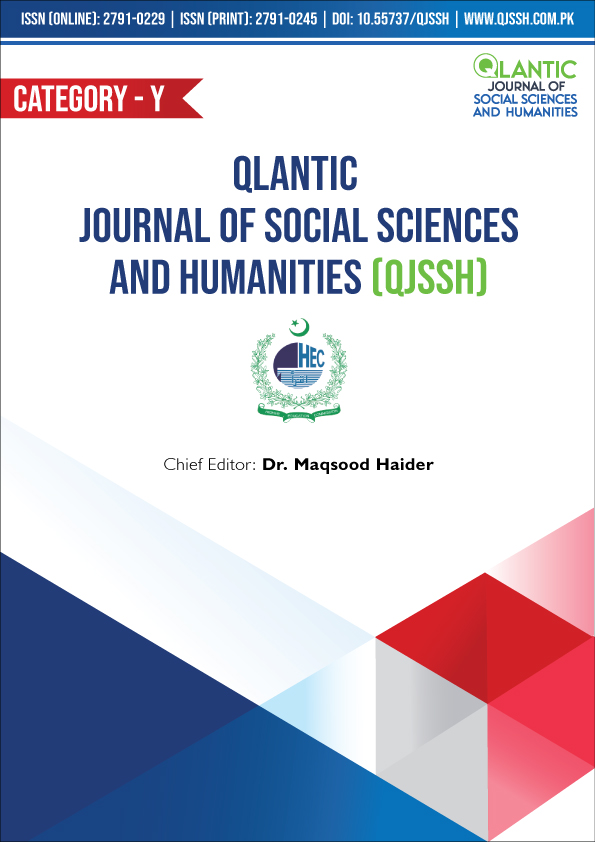Investigation of Binaries in Maleficent through Plumwood’s Ecofeminist Theory of Dualism: An Ecocritical Analysis
DOI:
https://doi.org/10.55737/qjssh.vi-i(CP).25306Keywords:
Dualism, Human Nature, Val Plumwood, Ecofeminism, Ecocriticism, Anthropocentricism, EcologyAbstract
The human soul is a complex amalgamation of malice and benevolence, reflecting the duality inherent in human nature. As the most intelligent beings on Earth, humans exert control over various aspects of life, often subjugating what they dominate, thereby creating a continuum of binary relationships. Disney's 2014 production, Maleficent, eloquently captures this dualism by depicting the protagonist as a combination of ecological and feminine traits. This research study employs Val Plumwood's ecofeminist theory of dualism as the theoretical framework to explore Maleficent as an ecofeminist protagonist. Plumwood's theory is critical in that it questions the hierarchical dualisms present in Western philosophy, including the bifurcation of nature and culture and women and nature's domination by patriarchal institutions. Through this paradigm, the paper aims to reveal the manner in which the movie challenges conventional gender roles and pushes against the anthropocentric worldview. By highlighting the ways in which popular media can represent and influence notions of gender and environmental ethics and by depicting Maleficent as a figure of resistance and rebellion against ecological and gendered oppression, the research contributes to the broader discussion of ecofeminism. By this examination, the paper will illustrate how Maleficent is not only a tale of individual revenge but also an insightful commentary on the intersections between environmental and feminist issues.
References
Arora, P., & Yadav, M. (2019). Maleficent as an Ecofeminist Protagonist: A Holistic Vision. The Criterion: An International Journal in English, 11. https://papers.ssrn.com/sol3/papers.cfm?abstract_id=4553799
Frye, M. (1983). Politics of reality: Essays in feminist theory. Crossing Press.
Gilbert, S., & Gubar, S. (2004). The madwoman in the attic. na.
Hariyati, N. R., & Tjahjono, T. (2022). Implementation of Vandana Shiva's Ecofeminism in 'Maleficent' Film on Literature Learning. International Journal of Multicultural and Multireligious Understanding, 9(1). https://waqafilmunusantara.com/index.php/2022/06/08/implementation-of-vandana-shivas-ecofeminism-in-maleficent-film-on-literature-learning/
Hb, G. P. (2020). An Ecofeminism Analysis of the Relationship Between Woman and Nature in Maleficent Novel: Feminist Approach [Doctoral dissertation]. Prodi Sastra Inggris.
Maria, M., & Vandana, S. (1993). Ecofeminism. Halifax: Fernwood. https://feministarchives.isiswomen.org/isispub/wia/wia1996-1/WIA19961_10EcoFeminism.pdf
Mathews, F. (2017). The dilemma of dualism. In Routledge Handbook of Gender and Environment (pp. 54–70). Routledge.
Maulina, R. D., & Nurhidayat, S. P. (2024). Gender Oppression in the Maleficent Movie by Robert Stromberg: A Feminist Perspective [Doctoral dissertation]. Universitas Muhammadiyah Surakarta.
McCaughrean, G. (1998). Greek Gods and Goddesses. Simon and Schuster.
Ott, B. L., & Mack, R. L. (2020). Critical media studies: An introduction. John Wiley & Sons.
Plumwood, V. (2002). Feminism and the Mastery of Nature. Routledge.
Sinha, A., & Mishra, P. (2019). Love, Desire and Ecstasy In Kalidasa’s Play Malvikagnimitram. Think India Journal, 22(14), 16664–16672. https://thinkindiaquarterly.org/index.php/think-india/article/view/18058
Warren, K. J. (1988). Toward an ecofeminist ethic. Studies in the Humanities, 15(2), 140. https://www.proquest.com/openview/d0a35135ac81f4d3b425b7f3d1cb5e56/1?pq-origsite=gscholar&cbl=1817297
Williams, R. (1975). The country and the city (Vol. 423). Oxford University Press.
Downloads
Published
Issue
Section
License
Copyright (c) 2025 Ayesha Farooqi, Sundus Ijaz

This work is licensed under a Creative Commons Attribution-NonCommercial 4.0 International License.





